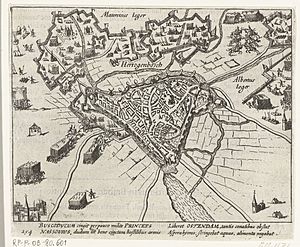Siege of 's-Hertogenbosch (1601) facts for kids
Quick facts for kids Siege of 's-Hertogenbosch (1601) |
|||||||
|---|---|---|---|---|---|---|---|
| Part of the Eighty Years' War and the Anglo-Spanish War (1585–1604) | |||||||
 Map of the siege of 's-Hertogenbosch by Simon Frisius. |
|||||||
|
|||||||
| Belligerents | |||||||
| Commanders and leaders | |||||||
| Strength | |||||||
| 12,000–15,000 22 guns |
Anthonie Schetz: 2 infantry companies and 2 cavalry companies Frederik van den Bergh: 7,000 infantry and 1,500 cavalry |
||||||
The Siege of 's-Hertogenbosch of 1601 was a military event during the Eighty Years' War and the Anglo-Spanish War (1585–1604). It happened between November 1 and 27, 1601.
During this time, Prince Maurice of Nassau and William Louis, Count of Nassau-Dillenburg led Dutch and English forces. They tried to capture the city of 's-Hertogenbosch in what is now the Netherlands. However, their attempt was not successful. The city was protected by about 1,500 to 2,000 Spanish soldiers. These soldiers were led by Governor Anthonie Schetz.
Contents
Why the Siege Happened
The Dutch forces wanted to take 's-Hertogenbosch to weaken the Spanish army. At the same time, a very long and difficult siege of Ostend was happening. The Dutch hoped that by attacking 's-Hertogenbosch, they could make the Spanish move some of their soldiers away from Ostend.
Maurice's Army
In July 1601, Prince Maurice had captured another city called Rheinberg. After this victory, he gathered a large army. He had thousands of foot soldiers and cavalry (soldiers on horseback). He also brought many cannons.
Why the City Was Hard to Capture
's-Hertogenbosch was a very strong city. It had excellent defenses that made it almost impossible to break into.
- Strong Walls: The city had very strong fortifications.
- More Soldiers: Spanish reinforcements kept arriving, making the defending army bigger.
- Loyal People: The people living in the city were very loyal to the Spanish side. This meant they would not help the attackers.
- Cold Weather: The weather was also a big problem. It was very cold, which made fighting and living outdoors difficult for the attacking army.
The End of the Siege
The siege ended when Albert VII, Archduke of Austria, who was a Spanish leader, sent help. He sent a relief force led by Count Frederik van den Bergh. This new Spanish army was heading towards 's-Hertogenbosch.
On November 26, Prince Maurice and his cousin William Louis realized the danger. They decided it was too risky to face the new Spanish army in an open battle. So, they began to pull their troops back. The siege officially ended on November 27, 1601.
What Happened Next
The Dutch attempt to capture 's-Hertogenbosch failed. This meant the Spanish could continue their strong attacks on Ostend.
Prince Maurice tried to conquer 's-Hertogenbosch again in 1603. But just like in 1601, he was forced to leave without taking the city.
See also
 In Spanish: Asedio de Bolduque (1601) para niños
In Spanish: Asedio de Bolduque (1601) para niños
- Battle of Nieuwpoort
- Siege of Ostend
- Siege of Lingen (1605)
- List of Governors of the Spanish Netherlands

